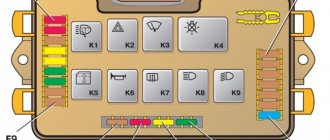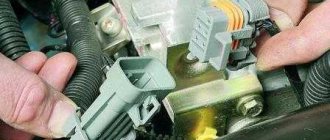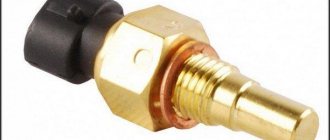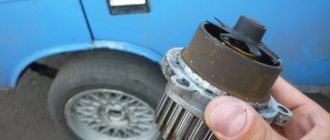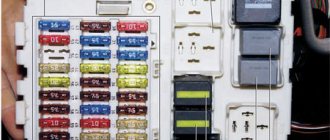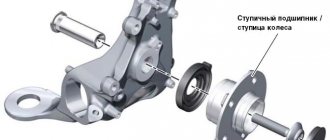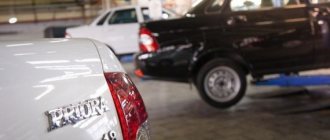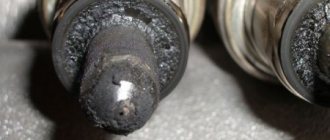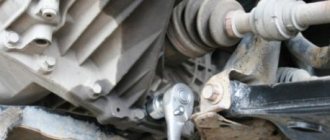Every car owner of an injection car sooner or later encounters problems in the fuel system and begins to think about cleaning the fuel injectors. The task of the injector is to maintain the pressure created by the fuel pump and only at the right moment to open for a fraction of a second to allow the required amount of fuel to pass through. There are a lot of different additives in the fuel, which during engine operation stick to the seat of the injector locking needle. As a result, the injector begins to spray fuel incorrectly or leak fuel when it should be closed. In such cases, it is necessary to clean the injectors or replace them. The recommended period for cleaning injectors is 25,000 km - 30,000 km. Failure to properly maintain fuel injectors can lead to their complete failure, and then only replacement will be necessary.
How to understand when it is necessary to clean fuel injectors
- Loss of dynamics during car acceleration.
- When you press the gas there are jerks and dips while driving.
- The engine is running rough and unstable.
- Fuel consumption has increased.
- It takes a long time to start the engine with the fuel pump running.
- Black smoke from the exhaust pipe.
There are many instructions and methods for cleaning fuel injectors on the Internet, but we recommend using the most reliable and proven one - cleaning in an ultrasonic stand.
How to remove and clean
- Turn off the fuel supply from the fuel rail.
- Disconnect the electrical connector for the fuel injectors.
- We unscrew the two bolts securing the ramp and pull it out.
- We remove the injectors from the ramp and install them in a special stand
- After cleaning, put everything back together in reverse order.
Further in our photo report there are more detailed instructions.
1We begin to remove the fuel injectors for further cleaning. The injectors are located behind the intake manifold.
2First of all, we need to relieve the fuel pressure from the fuel rail. To do this, unscrew the plastic cap indicated by the arrow in the photo.
3And use something sharp to press on the spool valve, first placing a container so as not to pour gasoline all over it.
4Having released the pressure, screw the plastic cap back on and unscrew the 5mm hexagon bolt securing the fuel rail.
5On the other side of the manifold, between the third and fourth injectors, there is another fuel rail mounting bolt.
6It is convenient to unscrew it using a small ratchet with extensions and a 5mm cue ball.
7Under the air filter bellows we need to disconnect the fuel supply hose to the ramp using two 17mm wrenches. And disconnect the electrical connector of the fuel injector wires.
8Now that everything is turned off, lift up the fuel rail with the injectors, pulling them out of their seat in the manifold.
9And we pull out the ramp with injectors and wires towards the right wing of the car.
10Located on the table, disconnect the electrical connectors from the fuel injectors by pressing the metal brackets on the sides of the connectors.
11Pull out the metal clamps of the injectors. They can be removed by hand, but if difficulties arise, you can use a screwdriver.
12We remove the injectors from the ramp and clean them of dirt, preparing them for installation in the stand.
13In a special stand for cleaning injectors, we create WYNN'S liquid pressure and make sure that the injectors do not allow liquid to pass through themselves. Then we turn on the intermittent opening of the nozzles and look at their spray. The liquid is sprayed filling the container in the stand.
14After cleaning the nozzles by passing liquid through them, we lower the nozzles into a container with WYNN'S liquid and turn on the ultrasonic cleaning mode, setting the timer for 30 minutes.
15After cleaning, replace the injector O-rings, if necessary, and install them back into the fuel rail. We recommend lubricating the O-rings with silicone grease before installation to avoid damaging them during assembly.
16It is also necessary to lubricate the rubber bands of the injectors on the installation side of the manifold.
17Here are all the tools needed to remove and install fuel injectors.
18The work is finished. Before starting the engine for the first time, you must turn the ignition on and off several times to fill the fuel rail with gasoline.
The VAZ 2114 (2115) is equipped with engines of 1.5 and 1.6 liters (8 and 16 valves), therefore the performance of the injectors must be selected depending on the type of engine.
If you make the wrong choice, fuel consumption may increase or the internal combustion engine may lose power. The VAZ 2115 injector is no different from the VAZ 2114, so when considering the device of the “fourteenth” model, we will also keep in mind the “15th”. Model 2114 can be equipped with fuel injectors from different manufacturers, and accordingly, the cost of the injectors may also differ. Manufacturers and cost (price range in the Russian Federation): • GM (1300 - 1400 rubles), • BOSCH (1000 - 1200 rubles), • SIEMENS (800 - 1400 rubles). Which injectors should I choose for replacement?
Here you should focus on the part markings.
For example, BOSCH 0 280 158 502 is only suitable for a 1.5 l 8-valve engine. It’s hard to say anything about the manufacturer; the quality of all products is approximately the same. . It is necessary to remove the pipe from the air filter. Remove the terminals from the battery. . We take some kind of container for draining gasoline. . We take a screwdriver and a container, approach the car, unscrew the cap from the valve on the fuel rail (TR), prying the valve nipple with a screwdriver, release the pressure (gasoline will flow from the FR), then screw the cap back on. . Next, we take the keys for 24 and 21 or 22 (so for a square TR, for a round one there are most likely two keys for 24, I don’t know for sure) and try to unscrew the tube that goes to the TR under the throttle pipe on the driver’s side and try to pull it out of the ramp. . Then he unscrews the fuel pressure regulator (FPR) with a ratchet or just a 6-point 5-pointer, we also try to pull it out of the TP, to do this we carefully pull up so as not to tear the white hose that goes from the RTD to the receiver. . We disconnect the chip, impulses pass through it to the injectors. . We unscrew the fuel rail (FR) itself with a ratchet or just a 6-point 5. We pull it towards the receiver, then, when the injectors come out, we turn the FR with the injectors up and carefully pull it out towards the right wing, everything came out and went back in without any problems! . We remove the wiring from the injectors, here you need a screwdriver, press your finger on the spring (U-shaped piece of iron). We try to push it upward with a screwdriver (towards the wires coming out of the injector). Next, we move the spring forward, one end should come out, the other will remain in place, pull the chip up, i.e. remove from the nozzle. . Now you need to remove the clamps from the injectors; to do this, use a screwdriver to pry them off on both sides. Then we try to pull them out with our hands or a screwdriver (whichever is more convenient) and pull them to the side. Then we pull the injector up, if there are rings left in the ramp, as I had, then we take them out with a screwdriver, they come out easily, don’t forget about the ring on the RTD, it’s better to change it in advance, I didn’t buy rings on the RTD, I left the old one. . Everything was removed. In fact, there are quite a lot of reasons why injectors may not work well. And the most common symptoms are described below: • Difficulty starting the engine in any weather; • The engine is running unsteadily; • The engine stalls at idle; • High crankshaft rotation speed at idle speed; • Loss of power, poor response to the accelerator pedal; • When you press the gas, shocks or dips may appear; • High gasoline consumption; • If the nozzle is dirty or damaged, it should be replaced or cleaned. There is no point in repairing it. It should also be noted that today injectors cannot last even 100 thousand km. The VAZ-2114 model can be equipped with different injectors from different manufacturers. Depending on this, durability and their cost also differ. It is recommended to buy not domestic parts, but from other companies, for example, GM, BOSCH, SIEMENS
.
Also, the choice of injectors also depends on the working volume and the number of valves. For 16-valve engines, the performance of such parts will be different than for the 8-valve version. If the parts are selected incorrectly, then most likely, gas mileage will be higher or the car will lose power. If we talk about choice, then preference should be given to the BOSCH brand at number 0280158502
. This is the serial number that is suitable for an 8-valve engine with a volume of 1.5 liters. Injectors fail not only because of their quality; their performance is largely affected by fuel that contains a lot of dirt or large fractions. Cleaning injectors at service stations will not be cheap. Therefore, if you do not check and clean it yourself, then you should think about whether it might be easier to buy new parts and replace them.
| Fastening bolts KAMAZ 740.60-360, 740.61-320, 740.62-280, 740.63-400, 740.64-420, 740.65-240, 740.70-280, 740.71-320, 740.72-360, 740.73-4 00, 740.74-420 and 740.75-440 caps of the main (liners) bearings (vertical) of the crankshaft (M16). ... After stopping the overheated ZMZ 409 UAZ Patriot engine, you need to inspect the cooling system and find the reason that caused it to overheat. As a rule, this can be a burst... The rear axle gearbox seal is responsible for the seal, and if it is slightly misaligned or worn out, the seal will be compromised, which will lead to oil leakage from the gearbox or dust, water and dirt entering the gearbox. On a VAZ 2107, replacing the oil seal x... The operation of each automobile engine depends on the quantity and quality of the air-fuel mixture prepared by a special device called a carburetor. All carburetor systems create the mixture and help distribute it evenly... |
| When soundproofing your car, you should understand that it is impossible to eliminate all external noise completely. You'll likely still hear road noise, especially in older cars, so don't expect complete silence. … For a few hours I came across an almost serial UAZ “Patriot” with two pedals. I’m sharing the details that I managed to find out. At the end of last year, it became known about the upcoming release of the “Patriot” with an automatic transmission Punch Powerglide 6L50, etc... Unlike other types of paint, automotive paints are specially designed for spraying and have a long service life on cars. Paint intended for any other purpose can lead to disaster if applied to a vehicle. ... UZAM-412 is a Moskvich 412 gasoline engine, which has established itself as a reliable and durable power unit, characterized by efficiency and ease of maintenance. This engine has been on the assembly line from 1966 to the present. For that… |
Injectors are an indispensable attribute of any car fuel system based on injection type engines. The injectors act as gasoline atomizers and determine the required amount of fuel to be supplied to the combustion chamber. However, during operation there is a gradual depletion of the injectors. To optimize the operation of the entire system and increase engine power, it is recommended to periodically clean and flush the injectors.
How to check fuel injectors on a fuel injection engine
There are several methods for checking the performance of an injector. Let us list them in order with a detailed indication of the algorithm of actions.
Check using resistance measurement
You can check the injectors without removing them using a multimeter. First, check which injectors are installed on your car - high or low impedance (electrical resistance). This data will be necessary to perform an accurate diagnosis. In order to check the injectors with a tester without removing them from the engine, you must adhere to the following plan:
Measuring the resistance of the injector winding
- remove the high-voltage wires from the injectors;
- set the multimeter to the mode for measuring insulation resistance (ohmmeter) in the range from 0 to 200 Ohms (depending on the technical parameters of the device, the upper limit may differ, the main thing is that the ohmmeter can show a resistance value of several tens of Ohms);
- turn off the ignition and remove the negative terminal from the battery;
- disconnect the electrical connector on the injector being diagnosed (as a rule, to do this, unclip the fastening clip located on the block body);
- connect the tester's measuring probes to the injector terminals and take measurements.
High impedance injectors have insulation resistances ranging from 11...17 Ohms, and low impedance injectors - 2...5 Ohms.
If the measured insulation resistance value differs significantly from the specified value, this indicates that the injector is faulty. Accordingly, the injector must be dismantled and detailed diagnostics performed.
Remember that when checking injectors with a multimeter, you need to diagnose all devices one by one! This way you can check which injector is not working.
It is important to know that the voltage to the injectors from the ECU is supplied in pulsed and not constant form. Therefore, it is recommended to measure resistance not only with an ohmmeter, but also with an oscilloscope, so you can see what peak values the resistance and voltage take. And the tester shows the average value.
How to check power to injectors
Checking the power supply to the fuel rail of VAZ 2110-2112
Let's look at checking the availability of power to the ramp using the example of VAZ 2110, 2111, 2112 cars, as some of the most popular. But first, let us recall that in the block with contacts, four of them supply power to the injectors, and one (pink wire with a black stripe) is the common ground. You need to act according to the following algorithm:
- disconnect the power plug;
- on the multimeter, set the upper limit of the measured resistance to around 200 Ohms (this value depends on the specific model of the tester);
- measure each of the four contacts from the injectors with a common connector in pairs.
The resistance value should be within 11.5...15.5 Ohms . Remember that this way you will only measure the power supply on the ramp to each injector.
You can check the injector simply for vibration. When the engine is running, a working injector should vibrate slightly . If there is no shaking, it means it is out of order.
Checking the power supply from the car's electrical circuit is quite simple, you just need:
- it is necessary to disconnect the supply wire block from each injector one by one;
- After this, use two pieces of wire to connect the injector directly to the battery;
- turn on the ignition.
If the injector starts spraying fuel, then the problem must be looked for in the wiring.
Be careful not to let fuel from the injector spill on you or other objects. Point its nozzle into a closed container.
How to check the starting injector
First, let's say a few words about the monoinjector. Today, such units are becoming less and less common, since the system is outdated. Its essence lies in installing only one injector - in front of the throttle valve. They can be found on old models of foreign cars from VW, Audi, Skoda, Seat and others.
Let us describe the algorithm for checking the resistance of an injector on a monoinjector:
- check the contacts from the injectors in pairs and compare them with the data from the manual (as a rule, these values should be within 1.2...1.6 Ohms);
- when checking pins 1 and 4, you need to make sure that the DATV (intake air temperature sensor) is working correctly; for this, also use the resistance data from the manual;
- if the resistance value is outside the acceptable limits, it is necessary to diagnose the injector in more detail.
Start injector
Often in old mono-injection engines, in addition to the valve injector, a so-called starting injector is also used, the task of which is to provide additional fuel when starting the engine, especially in cold weather and at high engine speeds, in order to facilitate its starting. Its operation time is determined automatically by the computer (in particular, a thermal relay), but as a rule, it lasts only a few seconds, after which it turns off as the engine starts and there is no need for its further use.
Its operation is completely similar to the operation of the nozzles in the injector. During operation, it may also partially or completely fail. A clear sign of such problems is the fact that a cold engine starts and immediately stalls. The starting injector is checked according to the following algorithm:
- pick up some small measuring container (like a glass);
- remove the injector from the engine and install it in the mentioned container;
- one contact of the injector is connected directly to the car’s battery, and the other to its “ground”;
- The fuel pump relay is also connected to the “plus” of the battery, thereby putting it into operation.
When operating and checking the pump, the injectors must be paid to the angle of fuel spray, as well as the amount of gasoline pumped. You will find reference data in the reference information for the injector that is installed in your car. As an indicative example, the data on the K-Jetronic system can be cited. In this case, the spray angle is 80°, and the volume is from 70 to 100 cubic centimeters of fuel per minute. Naturally, in other systems these indicators will be different.
After you have checked the operation of the mono nozzle, disconnect it and wipe it dry. In normal operating condition, its body is sealed. This means that fuel should not leak from it. Wait a while and make sure of this (1...2 minutes is enough for this).
Checking the injector by ear
Experienced motorists are able to check the condition and performance of injectors without removing them from the engine, in particular, by ear. To do this, use a regular rectangular board or, better yet, a stethoscope.
Place one edge of it tightly against the nozzle being tested, and the other edge to your ear. If the nozzle is in normal operating condition, then you will not hear any extraneous sounds or vibrations from it, only uniform clicks. But if it does not click or the sounds are not uniform, and other vibrations and knocks are also present, this means that the nozzle in question is clogged. And the stronger the knocks and noises, the greater the degree of blockage.
In general, you can listen to the injectors without the mentioned board. However, this requires relevant experience. The fact is that if the unit is faulty, a muffled high-frequency sound will be heard from the cylinder block, similar to a squeak or whistle. If you hear it while the engine is running, we recommend that you check the operation of the injector in more detail on a stand or ramp.
Checking the injector on the ramp
Fuel rail
Another method for checking injectors is with the fuel rail removed (it is removed together with the injectors, so this method can be classified as one that involves removing the injectors). To do this, the ramp is removed along with the injectors, and cups or other containers are installed under them to receive the fuel. In this case, it is advisable to remove the “negative” terminal from the battery and disconnect the supply wire harnesses. Before switching on, the circuit must be restored.
After this, connect the two fuel pipes and tighten the fittings holding them with a wrench. Next, you need to turn the starter for 10...15 seconds (but not longer, as this is harmful to it). It is important to note the shape of the “torch” under which the fuel is supplied, as well as the amount of gasoline in the glasses. If the injectors are working properly, the amount of gasoline in them should be the same. If this is not the case, then for further detailed diagnostics it must be removed and checked on a stand.
It will also be useful to notice whether gasoline is leaking from the injector when the engine is turned off. If this is the case, then it makes sense to check the integrity of the injector body, as well as the degree of its closure.
Checking the injector balance
Checking the injector balance
Let's look at checking the balance of injectors using the example of VAZ cars. Actions are performed in the following sequence:
- turn off the fuel pump and start the car in order to remove excess fuel pressure in the system (the car should run for a few seconds and stall);
- connect the pressure gauge to the fuel system;
- connect the fuel pump back into the system;
- connect a computer with the appropriate software and a cable for taking and diagnosing readings to the car’s computer.
Further actions are carried out in the software, with the help of which the fuel pump and injectors are turned on and off. The action algorithm for each of them is as follows:
- turn on the ignition;
- we check the readings on the pressure gauge (should be about 2.8...3 at);
- using the software, turn off the fuel pump relay;
- the pressure on the pressure gauge has dropped slightly (approximately 2.8 at);
- use the software to turn on the first injector;
- check the pressure on the pressure gauge (ideally, the pressure should not drop significantly);
- again, using the program, turn on the fuel pump relay in order to restore the pressure to the original 2.8...3 atm;
- then repeat the procedure with all the injectors, and then do not forget to restore the pressure in the system using the fuel pump.
Ideally, all injectors should show the same pressure release value. If in any of them the reset occurs with a very different value, this means that something is wrong with the injector, and additional diagnostics are needed.
After performing the described procedures, do not forget to completely relieve the pressure in the system. You need to connect the fuel pump and start the car, after which you can disconnect the pressure gauge.
Checking injectors on a bench
Injector testing stand
Mechanical characteristics affect the performance of injectors. And their verification is possible only at a special stand. You can read how to make it yourself in a separate article. In particular, at the stand they check:
- the amount of fuel passing through the injector;
- fuel pressure;
- the shape of the “torch” of the nozzle.
Checking a removed injector on a bench is the most accurate diagnostic method. With its help, you can determine the degree of damage to the injector and the feasibility of repair.
What injectors are installed on VAZ 2114/2115 cars
Almost all types of injectors that the VAZ 2114/2115 are equipped with at the factory can be considered interchangeable. Depending on the year of manufacture, injectors manufactured by Bosch and Siemens of different markings were installed on the car. Bosch injectors:
- Model 0280 158 022. The product is compatible only with a 16-valve engine with a volume of 1.6 liters.
The nozzle is black and is designed to operate at an optimal pressure of 3.8 atmospheres.
- Model 0280 158 017. An injector with this marking is installed on 8-valve engines with a volume of 1.6 liters. The body is also black.
- Modification 0280 158 996 is considered obsolete, since injectors with this marking were installed on cars until 2006. The model was intended for 8-valve power units.
Standard equipment for VAZ 2114/2115 injection engines Siemens injectors:
- VAZ20734 is made in an orange case. The model can be installed on a VAZ 2114/2115 of any year of manufacture, but the modification is paired with an 8-valve engine.
- Model VAZ20735 is intended for a 16-valve engine. In terms of its characteristics, it is practically no different from the previous model. The nozzle has a blue marking.
Depending on the marking, it can be used on different types of engines.
What are the types of injector malfunctions?
On injection engines, two types of injectors are used - electromagnetic and mechanical.
The electromagnetic injector operates on the principle of a valve, which, depending on the signal from the vehicle's control unit, opens, injecting the required amount of fuel into the cylinder.
The mechanical nozzle opens under pressure. It is based on a spring and a needle. It works as follows: when fuel is supplied, a certain pressure is created, the needle rises and fuel is sprayed into the cylinder.
Nowadays, mechanical injectors are practically not used on modern cars, so we will talk about malfunctions of electromagnetic injectors.
Since the nozzle is a fairly simple part in its structure, it can have several faults:
- No signal from the control unit
- Internal winding break or other malfunction
- Contamination of fuel supply channels
As a rule, most often the injectors stop working as they should due to contamination.
Replacing injectors
The difficulty in identifying problems in the operation of injectors is that the fuel system is quite branched and it is necessary to diagnose the functionality of all its parts. For example, a malfunction such as a decrease in engine power can have two reasons - failure of the injectors or exhaustion of the pump's life.
Clogged injectors can result in sudden jerking of the engine while driving or unstable idle speed. In addition, an increase in fuel consumption can be considered a sign of injector failure.
You can check the functionality of each injector even without removing them. Simply start the engine and remove the wires from the connector of each injector one by one. If immediately after removal the engine starts to twitch or stalls, then the injector is fine. If the stability of the engine does not change with removal of the wire, then the injector needs to be thoroughly cleaned or even replaced.
This material will help you to independently replace or wash the injectors on VAZ 2110-2112 cars: https://vazweb.ru/desyatka/pitanie/zamena-forsunok-vaz-2110-8-klapanov.html
Extending the life of injector nozzles
How to extend the life of injectors? At the initial stage, with low mileage, various special additives that are added to the gas tank with fuel can help out. They can be bought in specialized stores, car markets and junkyards.
The cost of additives is low. This method is good if you do it regularly, and it can extend the life of the injectors, but it will not clean them completely. Some car enthusiasts, on the contrary, are against the use of chemicals, believing that additives clog the injector even more.
It is recommended to clean the injectors every 40 thousand km. Many auto repair shops provide cleaning services. The cost starts from 1,500 rubles, and the procedure is done on special equipment using ultrasound. But in order to save time and money, you can carry out this procedure yourself. Cleaning the VAZ 2114 injectors with your own hands is not difficult even for a beginner. But first you need to determine the performance of the injector nozzles. If you suspect this malfunction, then how to check the injectors of the VAZ 2114? Many car enthusiasts do this on a special stand, but it makes no sense to buy it for rare diagnostics. In this article we will talk about checking without additional devices.
How to remove
The procedure for dismantling and installing injectors is not particularly difficult, but it does take a lot of time. You need to prepare a set of tools in advance:
- 2 open-end wrenches for 17;
- crosshead screwdriver;
- screwdriver with a flat thin blade;
- hex key 5.
None To relieve fuel pressure, you must turn off the fuel pump. It is located in VAZ 2114/2115 cars in the fuel tank. The easiest way to get to the pump is through the hatch located under the rear seat cushion. For this:
- The seat needs to be reclined.
- Find a small hatch under the rug.
- Unscrew the screws securing the hatch.
- Remove the cover and remove the contact block from the fuel pump housing.
Then you need to start the engine. The engine will run on the amount of fuel that remains in the system, since the pump will not build up pressure after removing the block. You must wait until the engine has completely used up the remaining gasoline and stalls.
None The procedure for removing injectors is as follows:
- Open the hood of the car and remove the wire from the negative terminal on the battery.
- For ease of dismantling, it is recommended to remove the air filter box. It will prevent free access to the engine.
- After that, use your finger to snap off the plastic retainer on the engine and disconnect the connector from the throttle valve.
- The connector from the idle air control regulator is removed in the same way.
- Next, you need to disconnect the connector block from the wiring harness of the injectors themselves.
- The injectors can only be removed together with the fuel rail. Therefore, you need to unscrew the bolts securing the ramp to the body.
- After which it will be possible to move the ramp to the side so that each of the nozzles moves slightly out of the mounting socket. The wires are removed from the injectors, otherwise it will be impossible to pull out the ramp.
- The ramp is pulled out and placed in a clean place. Now you can easily remove all the injectors - they are pressed out using a plastic clamp.
Disconnecting the injectors is possible only after dismantling the ramp itself. Accordingly, new products are inserted in place of the old ones. And then the installation work is carried out in the reverse order.
Repair of injectors VAZ 2114/2115
Repairing injectors involves carrying out a number of works at once:
- cleaning;
- purging;
- replacement of rubber seals.
After the products have been removed from the fuel rail, you need to take a good look at each of the four nozzles. If there are visible signs of leakage on the body, repair will not be practical. You will have to immediately replace the nozzle with a new one.
The differences in flushing and cleaning procedures for 8-valve and 16-valve engines are not significant. Therefore, you can be guided by the same scheme.
The main signs of injector malfunction on a VAZ-2114: check and signs of clogging
If, while driving, your car lost its dynamics, began to accelerate more slowly, and in general there were interruptions in its stable operation due to difficult starting and increased fuel consumption, one of the injectors installed on the engine may have failed. In this article we will tell you in detail how to check them, and what are the nuances in such work.
Removing the injector from the VAZ-2114 fuel rail
Depending on which of the injectors has failed, the replacement process is absolutely identical.
As a rule, nothing prevents you from removing the lock.
The bracket will come out of place if you pry it with a screwdriver.
Video: the easiest way
If the body is clean and there are no deformations or cracks on it, then repair work is allowed . To do this, you will need to remove the seal from the body and the sprayer. It is recommended to leave these parts in acetone or solvent for 1.5–2 hours. While the parts are being washed, you can use a vacuum cleaner to clean the fuel rail. Next, you need to carefully clean the place where the injectors fit into the ramp using a toothpick or a needle.
After this, you can start purging the nozzle from the inside. You will need a roll of electrical tape, an aerosol can for cleaning carburetors and a syringe. An aerosol cleaning liquid is supplied through a thin syringe into the nozzle cavity.
It is better to wrap the joint between the syringe and the tube of the canister for sealing with electrical tape. It is recommended to repeat washing the nozzle from the inside three times. Afterwards the product must dry.
A cheap product will perfectly remove dirt and deposits from the nozzle. Before installation, each nozzle is tested for resistance. The tester readings should be in the range of 11–15 ohms.
There is also a simple way to clean the injectors, without dismantling the fuel rail. However, it is only appropriate in cases where the injectors have not yet exhausted their entire service life (120–150 thousand kilometers). The use of cleaning additives in gasoline is allowed. In this case, all elements of the fuel system will be cleaned, but its closed nature does not allow removing dirt and sediment from low-quality gasoline.
A broken fuel pump can cause serious problems. You can read more about this here: https://vazweb.ru/desyatka/pitanie/zamena-toplivnogo-nasosa-vaz-2114.html
The liquid is poured into the gas tank and, together with the fuel, cleans all elements of the system.
Replacing rubber rings and seals on injectors
Usually, when washing or repairing injectors, car enthusiasts immediately change all rubber elements. This is due to high wear rates. The cost of rings and seals is very low, but after replacement you can immediately observe the stability of the motor.
Rings and seals can be removed with one movement of the hand. However, installing new ones will require care, as it is easy to damage the rubber. The plastic element is first lubricated with gasoline, and then pulled in place of the old seal.
Spare parts for VAZ injectors can be purchased at a minimal price. Almost every driver can clean or replace the injectors on VAZ 2114/2115 cars on their own. Difficulties can arise only in the process of unscrewing the fuel rail or reconnecting the wires to the injector contacts. However, if each stage of work is carefully carried out, even a beginner can independently maintain this element of the fuel system.
- Author: Veniamin
Before moving on to the procedure for removing injectors, I recommend that you first become familiar with what INJECTORS are and what functions they perform in the power supply system of an engine with distributed injection. You can read about this in detail on the website in the article Fuel injectors.
Checking injectors without removing them
First of all, with the engine running, you need to feel the injectors with your hand. Normally they vibrate as they constantly open and close. If any injector does not vibrate, this indicates that it is not working.
You can also additionally check the operation of the injectors by unscrewing the cap nuts with the engine running. If the speed decreases when unscrewing, the injector is working. If, after unscrewing the nut on any injector, the speed does not change, this indicates a problem with the injector.
There are several reasons for failure:
- the control signal does not arrive;
- No power supply;
- the injector has failed.
At the initial stage, you need to check the power to the injector, connectors, contacts, wiring, etc. If the diagnostics are inconclusive, the injector may need to be replaced.
